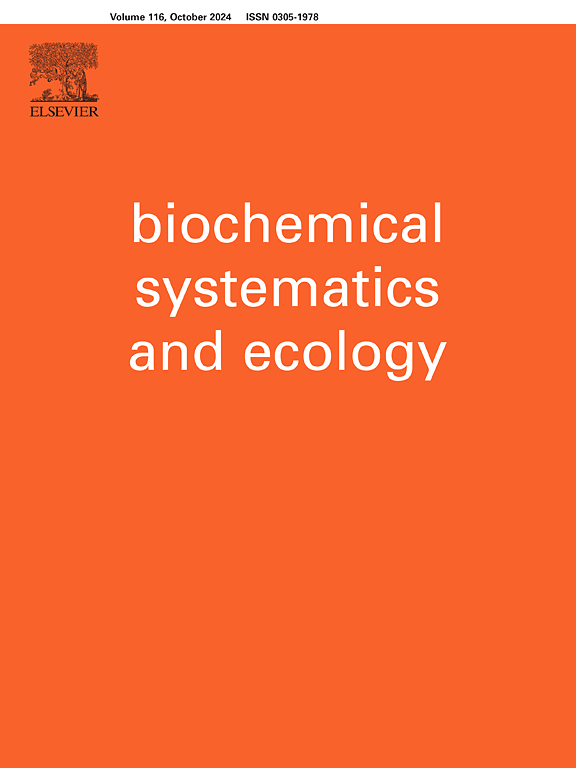Lipid profiles and DNA barcoding markers reveal the genetic delimitation between species of the Carapa genus native from the Amazon
IF 2
4区 生物学
Q4 BIOCHEMISTRY & MOLECULAR BIOLOGY
引用次数: 0
Abstract
Authentic identification of Amazonian tree species is important for conservation and their sustainable exploitation. This work aimed to characterize the inter- and intraspecific divergence in two taxonomic units of the genus Carapa using the lipidomic profile of the seed oils, analyzed by gas chromatography-mass spectrometry (GC-MS) and DNA barcoding molecular markers to identify and discriminate differences between Carapa species. Seeds and leaves of 53 individuals were collected and morphologically grouped into Carapa guianensis and Carapa vasquezii. The oils extracted from seeds were esterified, and their lipidomic profiles were analyzed. Two chloroplast genome regions (psbA-trnH and rbcL) were amplified for genetic diversity analyses and the barcoding-gap test. The lipidomic profile allowed the identification of 40 substances present in the C. guianensis and C. vasquezii oils, with 20 shared among the species independent of the region of collection, two occurring only in the oil of C. guianensis from Acre, four in samples of C. guianensis and C. vasquezii from Amazonas, and 16 substances occurring only in samples of C. vasquezii oil. C. vasquezii presented a greater diversity of terpenoids. The genome regions made it possible to obtain 16 distinct haplotypes for the two species (C. guianensis and C. vasquezii), 999 conserved sites, and 32 polymorphic sites. The species presented significant molecular divergence (FST = 0.87), and the rbcL region was considered promising for barcode studies at levels ranging from 0.1 to 0.2% of genetic distance. The results suggest that the two species morphologically identified C. guianensis and C. vasquezii constitute genetically divergent biological groups.
脂质谱和DNA条形码标记揭示了原产于亚马逊的卡拉帕属物种之间的遗传界限
亚马逊雨林树种的真实鉴定对保护和可持续开发具有重要意义。本研究通过气相色谱-质谱联用(GC-MS)和DNA条形码分子标记技术,分析了卡拉帕属两个分类单位的种间和种内差异,以鉴定和区分卡拉帕属植物之间的差异。收集了53个个体的种子和叶片,并将其形态分类为贵阳卡拉帕和瓦斯奎兹卡拉帕。对种子中提取的油脂进行酯化,并对其脂质组学特征进行分析。扩增两个叶绿体基因组区域(psbA-trnH和rbcL)进行遗传多样性分析和条形码间隙测试。通过脂质组学分析,鉴定出40种物质,其中20种在不同采集区域的物种中共有,2种只存在于阿克地区的桂楠油中,4种存在于亚马孙地区的桂楠和桂楠油中,16种只存在于桂楠油中。凡士兰的萜类化合物多样性较大。这些基因组区域使得这两个物种(桂楠和巴斯奎兹)有可能获得16个不同的单倍型,999个保守位点和32个多态性位点。该物种存在显著的分子差异(FST = 0.87), rbcL区域在0.1 - 0.2%的遗传距离范围内被认为有希望进行条形码研究。结果表明,经形态学鉴定的两种贵州蠓和vasquezii蠓构成了遗传上不同的生物类群。
本文章由计算机程序翻译,如有差异,请以英文原文为准。
求助全文
约1分钟内获得全文
求助全文
来源期刊

Biochemical Systematics and Ecology
生物-进化生物学
CiteScore
3.00
自引率
12.50%
发文量
147
审稿时长
43 days
期刊介绍:
Biochemical Systematics and Ecology is devoted to the publication of original papers and reviews, both submitted and invited, in two subject areas: I) the application of biochemistry to problems relating to systematic biology of organisms (biochemical systematics); II) the role of biochemistry in interactions between organisms or between an organism and its environment (biochemical ecology).
In the Biochemical Systematics subject area, comparative studies of the distribution of (secondary) metabolites within a wider taxon (e.g. genus or family) are welcome. Comparative studies, encompassing multiple accessions of each of the taxa within their distribution are particularly encouraged. Welcome are also studies combining classical chemosystematic studies (such as comparative HPLC-MS or GC-MS investigations) with (macro-) molecular phylogenetic studies. Studies that involve the comparative use of compounds to help differentiate among species such as adulterants or substitutes that illustrate the applied use of chemosystematics are welcome. In contrast, studies solely employing macromolecular phylogenetic techniques (gene sequences, RAPD studies etc.) will be considered out of scope. Discouraged are manuscripts that report known or new compounds from a single source taxon without addressing a systematic hypothesis. Also considered out of scope are studies using outdated and hard to reproduce macromolecular techniques such as RAPDs in combination with standard chemosystematic techniques such as GC-FID and GC-MS.
 求助内容:
求助内容: 应助结果提醒方式:
应助结果提醒方式:


